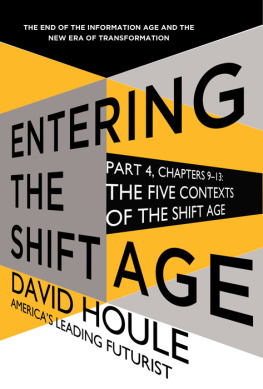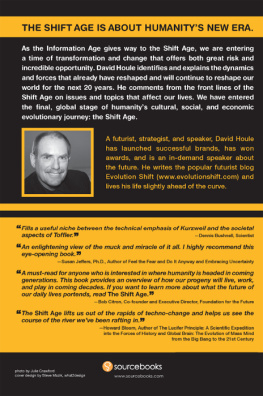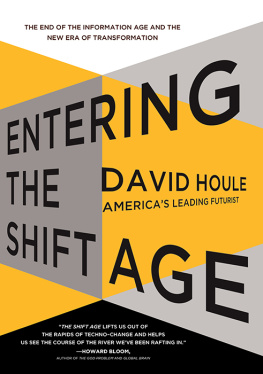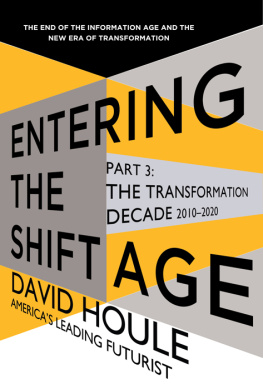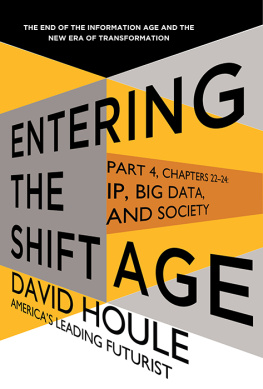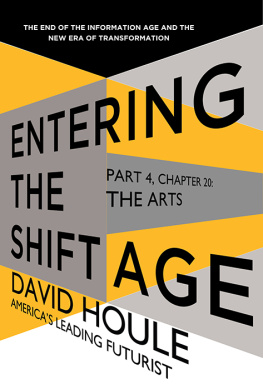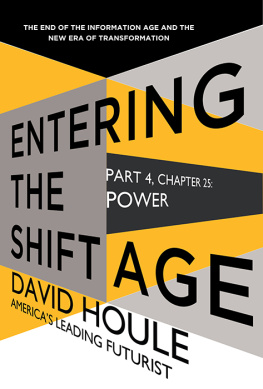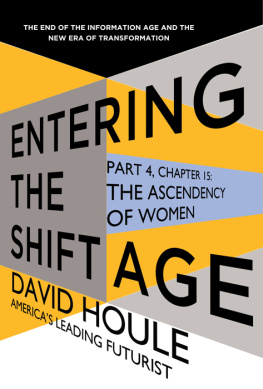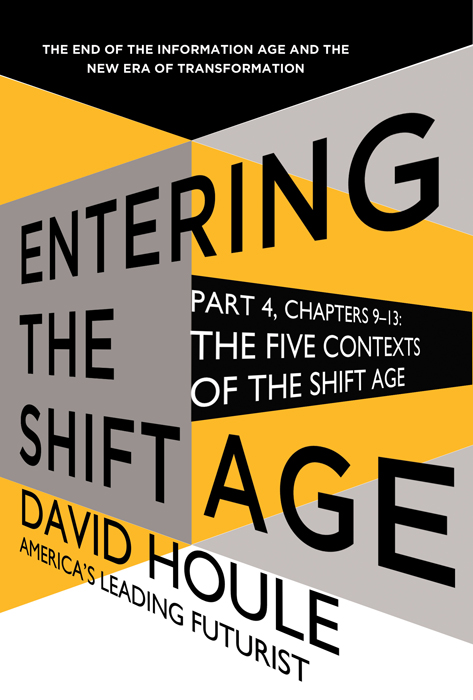
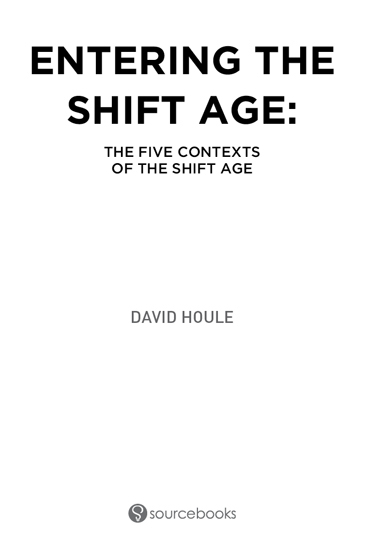
Copyright 2012 by David Houle
Cover and internal design 2012 by Sourcebooks, Inc.
Cover design by Studio Gearbox
Sourcebooks and the colophon are registered trademarks of Sourcebooks, Inc.
All rights reserved. No part of this book may be reproduced in any form or by any electronic or mechanical means including information storage and retrieval systemsexcept in the case of brief quotations embodied in critical articles or reviewswithout permission in writing from its publisher, Sourcebooks, Inc.
This publication is designed to provide accurate and authoritative information in regard to the subject matter covered. It is sold with the understanding that the publisher is not engaged in rendering legal, accounting, or other professional service. If legal advice or other expert assistance is required, the services of a competent professional person should be sought. From a Declaration of Principles Jointly Adopted by a Committee of the American Bar Association and a Committee of Publishers and Associations
All brand names and product names used in this book are trademarks, registered trademarks, or trade names of their respective holders. Sourcebooks, Inc., is not associated with any product or vendor in this book.
Published by Sourcebooks, Inc.
P.O. Box 4410, Naperville, Illinois 60567-4410
(630) 961-3900
Fax: (630) 961-2168
www.sourcebooks.com
CONTENTS
PART 4
THE FUTURE
OF HUMANITY
In Part Four, we will look at the future by first focusing on some large concepts and contexts of the Shift Age, followed by a close look at particular segments of society and humanity.
In Part Two, we looked at the three dominant forces of the Shift Age: The Flow to Global, The Flow to the Individual, and Accelerating Electronic Connectedness. These three forces are driving several big ideas that are initiating massive change now, and will have largely reshaped our world by the year 2025.
One clear difference between the Information Age and the Shift Age is content and context. The true clich of the Information Age was content is king. The reality of the Shift Age is context is king. Entering the Shift Age, we live in an increasingly contextual world. I have selected the five contexts I think have the greatest impact and influence.
THE FIVE MAJOR UNDERLYING CONTEXTS OF THE SHIFT AGE
1.The Earth Century
2.The need to retrofit the twentieth century
3.The Concept of Place has changed forever
4.The merging of biology and technology
5.The move toward an evolutionary shift in human consciousness
So now let us begin by taking a look at these five contexts, and then explore what much of society will look like in the years and decades ahead. Some of the areas we will explore the future about are Shift Age Generations, Education, Technology, Energy, Brands and Marketing, the future of the Nation-state and Powerall areas that will have transformational change.
Its time to enter the Shift Age and our collective future.
CHAPTER NINE
THE EARTH CENTURY
The first large context through which we must view the Shift Age is that the twenty-first century is the Earth Century.
Humanity has entered the twenty-first century with a rapidly growing awareness that it is having a significant effect on Earth. Environmental awareness, climate change, drought, record heat, and extreme weather are all showing us that something dire is going on with our planet.
And there is increasing evidence that we are causing this adverse effect on Earth. This understanding will shape a great deal of the change we experience in the Shift Age.
A Quick Look Back
Earth Day was first celebrated in 1970. This event, to some degree, was a result of the question Stewart Brand asked in the late 1960s: Why havent we seen a picture of the whole earth? Then we had the classic earthrise photo taken from an Apollo spacecraft in 1968. What we all saw stunned us. There, in the midst of infinite blackness, was this beautiful blue and green planet we call home. It looked so finite, and indeed fragile, that we understood the name Spaceship Earth. Alone in the midst of infinite space was our home, our only home.
This photo arguably launched the environmental movement, with Earth Day 1970 being a formal beginning. This environmental mindset took a while to take off, however.
Then, in the 1990s and into this century, environmental consciousness exploded. As a Baby Boomer parent, I marveled at the commitment my young son had to recycling. It showed me that a new generation was being raised with embedded environmental awareness that was far more fully developed than any I had known prior to the first Earth Day.
When Al Gore came out with his Inconvenient Truth presentation and film in 2006, it was clear that this awareness had gone beyond the new younger generation, the hardcore environmental movement, and a growing body of scientists. While this event, and to some degree Mr. Gore himself, triggered a backlash, the direction was clear.
All of us, to a greater or lesser degree, were now living in both the conversation about mans effect on Earth and that developing reality.
Helping to Shape the Thinking
In early 2006, I started my blog Evolutionshift, with the tag line A Future Look at Today. In the first two to three years I wrote a lot about energy, alternative energy, climate change, and other environmental issues. I became known early on as a thought shaper regarding such topics, which led to invitations to attend conferences and to speak. A few years later, when blogs had truly gone mainstream, I started to get lots of in-bound solicitations to write about this new green product or that new LEED certified building, to review a new book on some environmental subject, or perhaps to interview a scientist or environmental entrepreneur. In other words, I had gotten on the larger PR radar as someone with an audience who should be pitched stories and interviews.
A thought shaper is a person who creates, shapes and drives the perspectives and discussions surrounding various ideas and thoughts.
In 2011, all of this simply became too much. Though Earth Day was in late April, I started to get pitched story ideas for columns around Earth Day starting in early March. By early April there were half a dozen inbound solicitations every day. All of these folks seemed to think that their product was a great green product and that Earth Day was a great marketing hook or tent pole. Earth Day was perceived as a marketing event. This prompted a strong reaction in me.
In my Earth Day column that year, I spoke of my disgust with this view and said that Earth Day was not a marketing event, that it was no longer an Earth Day, an Earth Month, or even an Earth Year. While Earth Decade was somewhat more palatable, I basically said that we all had to think differently and that what we really needed to do was to think of the twenty-first century as the Earth Century, thereby coining a phrase I have used ever since. In that column I wrote:
The twenty-first century will be the Earth Century. It will be during this century that humanity faces the reality of whether it wants to destroy itself and much of what exists on this magnificent planet or not. Assuming we make essential course corrections, future historians will write about the Earth Century as a turning point in human history.

